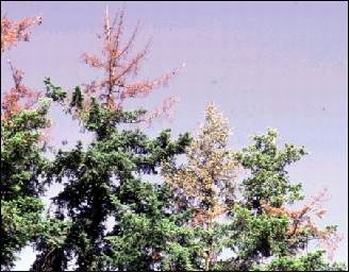
Publisher:
Bonnie King
CONTACT:
Newsroom@Salem-news.com
Advertising:
Adsales@Salem-news.com

~Truth~
~Justice~
~Peace~
TJP
Aug-06-2007 09:44

 TweetFollow @OregonNews
TweetFollow @OregonNews
Weather, Insects Taking it's Toll on Oregon Douglas Firs
Salem-News.comSo far, economic impacts on forestry are unknown.
 Individual branch death on Douglas firs often appears the year following extreme drought. Photo courtesy: ODF |
(CORVALLIS, Ore. ) - Driving through forested regions surrounding Oregon's Willamette and Umpqua Valleys this summer, you may have noticed reddish dead branches, tops or whole dead Douglas fir trees.
These trees may be reflecting physiological stress from the effects of extreme swings in weather over the past year and a half, says Rick Fletcher, forester with the Oregon State University Extension Service.
After experiencing months of saturated soils in the winter, then bone dry periods in the spring and summer, some Douglas firs planted in less than ideal situations are showing what some foresters call "flare out," the occasional dead branch, top or the entire tree.
So far, most of the stressed trees seem to be limited to Douglas, Lane, Benton, Linn, Yamhill, Polk and Marion counties, from the areas surrounding McMinnville, south to Roseburg, according to local OSU Extension foresters.
Douglas firs in western Oregon's northern and westernmost counties, including Clackamas, Washington and the coast seem relatively unaffected.
So far, economic impacts of this stress on forestry are unknown.
"Starting in December, 2005 and January, 2006, we experienced 44 days of straight precipitation, an all time record of consecutive days," said Fletcher. "These conditions left many Valley foothill sites with water logged soils for weeks on end, a recipe for disaster for wet-intolerant species like Douglas fir."
In waterlogged soils, many fine roots die, leaving the tree to try and regrow these roots in the spring, stressing the trees, Fletcher explained.
"The summer of 2006 was very hot, with three separate periods of temperatures in excess of 100 degrees," said Fletcher. "These hot, dry conditions were with us for 110 straight days, putting trees in severe moisture stress.
"This one, two, three punch was devastating for trees on marginal soil types, leaving them easy picking for a host of insects and diseases," Fletcher said. "Samples I have examined are suffering from a range of problems such as twig weevils, coneworms, root rot and bark beetles. It would be too easy to point fingers at one of these problems as being the cause, when in reality, it is the weather conditions that are much more to blame."
Typically, species like Douglas fir find these extremes in soil conditions marginally acceptable for growth, under more average climate conditions, said Fletcher. But this series of events during the past 17 months have just been too harsh for Douglas fir on these sites.
While many different tree species seem to be affected, young Douglas-fir on marginal growing sites are taking the worst of the damage, he said. "Around the Willamette Valley foothills, Douglas fir has been planted and comes in naturally on soils that are shallow and droughty, seasonally wet, or in some cases both."
Flare-out is common to the south as well, in the Umpqua Valley, according to John Punches, OSU Extension forester in Douglas County. "The situation is most common here on lower elevation, south and west facing slopes that tend to be hotter and drier, where moisture stress is exacerbated by unmanaged competition from grass and brush," he said. "Local landowners often assume that Doug fir will grow on these sites. They may under optimum weather conditions, but these less than ideal conditions invariably result in significant branch, top and whole tree mortality."
Some commercial Christmas trees are being affected as well, said Dave Shaw, Extension forest health specialist at OSU.
But Shaw thinks the stress seems to be limited to those trees growing in soils that are less productive — those waterlogged in the winter and dry as a bone in the summer.
"Across any given property it is likely that the problem is patchy and not evenly distributed," said Shaw. Once the rains come in, the extent of impacts will be clearer, he said. Then, healthy trees will green up and stressed parts will not.
These OSU Extension foresters say that the growing conditions for Doug-fir are looking more moderate this year.
"Even though our spring was short on precipitation, overall, the growing conditions we have been experiencing in 2007 are much more average than what we experienced in 2006," said Fletcher. "But it will take time for the trees to recover from 2006."
Similar Douglas fir die-off occurred in other recent years, especially in 1998-99, said Fletcher.
Articles for August 5, 2007 | Articles for August 6, 2007 | Articles for August 7, 2007
Quick Links
DINING
Willamette UniversityGoudy Commons Cafe
Dine on the Queen
Willamette Queen Sternwheeler
MUST SEE SALEM
Oregon Capitol ToursCapitol History Gateway
Willamette River Ride
Willamette Queen Sternwheeler
Historic Home Tours:
Deepwood Museum
The Bush House
Gaiety Hollow Garden
AUCTIONS - APPRAISALS
Auction Masters & AppraisalsCONSTRUCTION SERVICES
Roofing and ContractingSheridan, Ore.
ONLINE SHOPPING
Special Occasion DressesAdvertise with Salem-News
Contact:AdSales@Salem-News.com
googlec507860f6901db00.html




Terms of Service | Privacy Policy
All comments and messages are approved by people and self promotional links or unacceptable comments are denied.
[Return to Top]
©2025 Salem-News.com. All opinions expressed in this article are those of the author and do not necessarily reflect those of Salem-News.com.